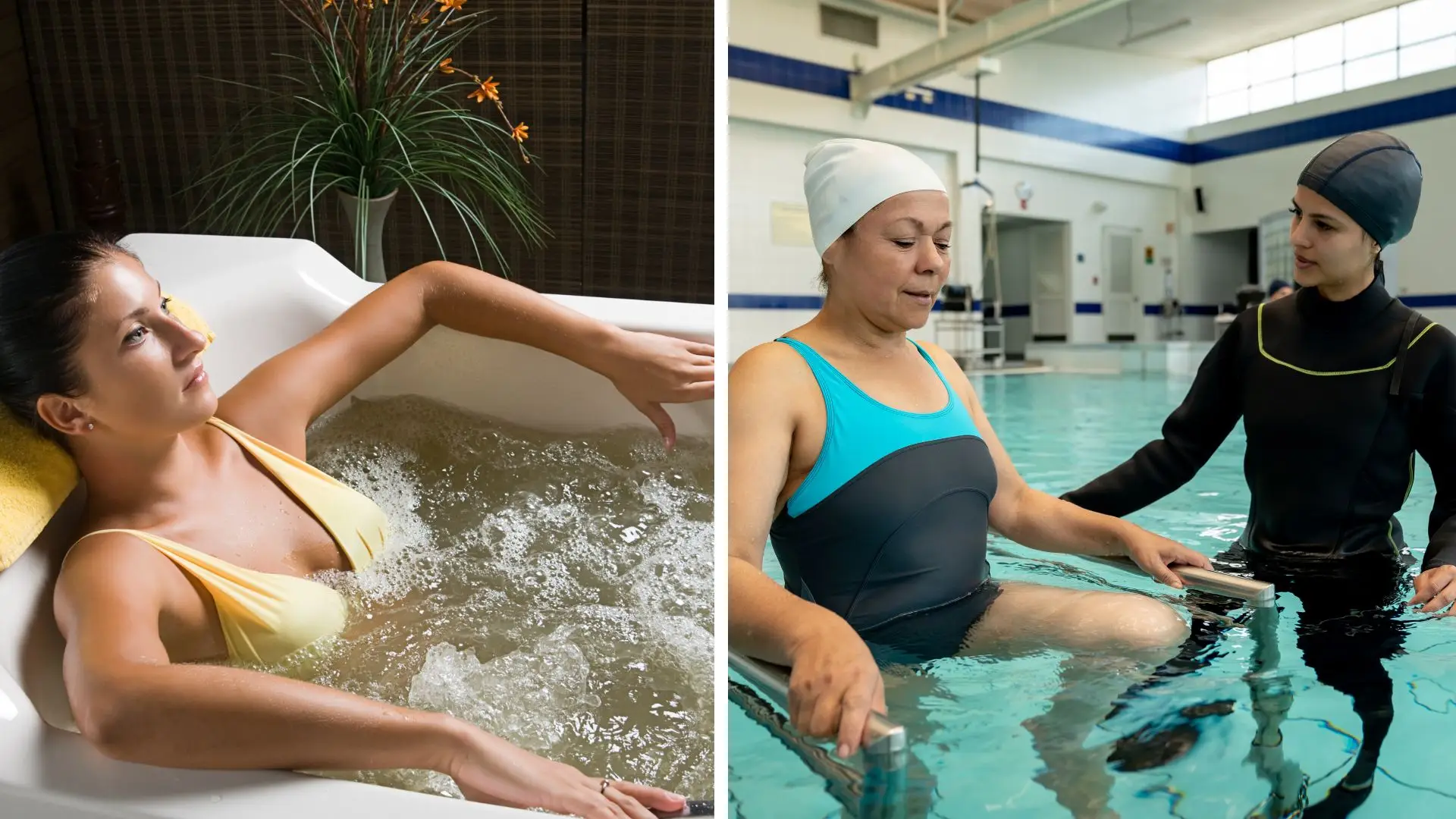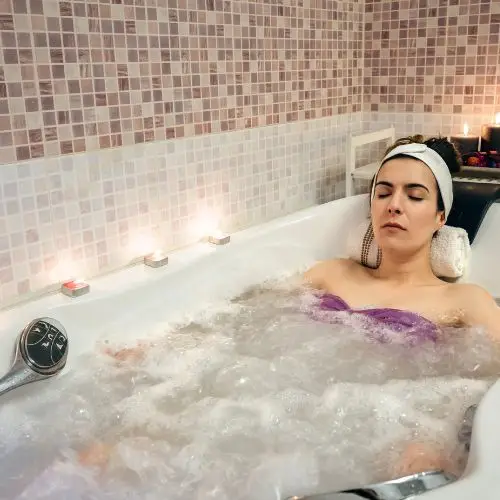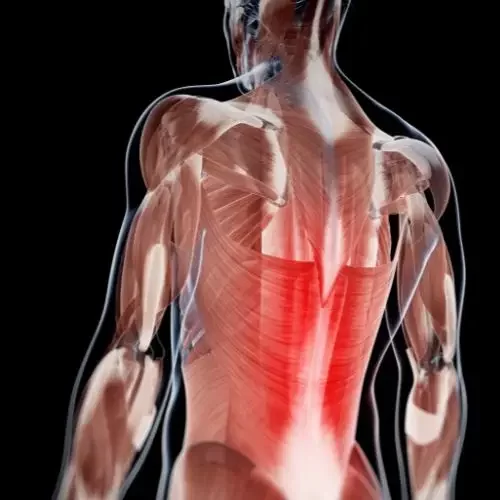
The Power of Water: Hydrotherapy Techniques for Chronic Pain Management
Hydrotherapy, also known as water therapy, has gained popularity as a natural and holistic approach to managing chronic pain.
Hydrotherapy can be a beneficial approach for managing chronic pain. The buoyancy and warmth of water can help alleviate pain, reduce muscle tension, and improve mobility without putting excessive stress on joints.
Aquatic exercises in a controlled environment can strengthen muscles, increase flexibility, and enhance overall fitness, which may indirectly alleviate chronic pain by supporting the body’s natural mechanisms for pain relief.
Five Reasons Why Hydrotherapy Helps With Relief From Pain
1. Reduced Pressure on Joints: Immersing your body in water provides buoyancy, reducing the pressure on your joints. This makes hydrotherapy an ideal choice for individuals with chronic back pain, arthritis, fibromyalgia, and joint pain.
2. Increased Blood Circulation: The warm water used in hydrotherapy dilates blood vessels, promoting better blood circulation. Improved blood flow helps deliver oxygen and vital nutrients to the affected areas, reducing pain and inflammation.
3. Muscle Relaxation: Hydrotherapy involves targeted water-based exercises and gentle movements that can alleviate muscle tension and spasms. This makes it an effective treatment for chronic muscle pain and spasms.
4. Stress and Anxiety Reduction: Chronic pain often takes a toll on mental health. Hydrotherapy provides a soothing and relaxing environment, helping to reduce stress and anxiety levels. This is particularly beneficial for individuals with chronic migraines, neck and shoulder pain, nerve pain, and autoimmune conditions.
5. Improved Range of Motion: Hydrotherapy exercises can help increase flexibility and range of motion, easing the stiffness associated with chronic pain. This is particularly advantageous for individuals recovering from surgery or those experiencing limited mobility due to their condition.
Hydrotherapy offers a multitude of benefits for chronic pain sufferers. Whether you are dealing with chronic back pain, fibromyalgia, arthritis, joint pain, migraines, neck and shoulder pain, nerve pain, post-surgical pain, muscle pain, or autoimmune conditions, hydrotherapy can provide relief and improve your overall well-being. By reducing pressure on joints, increasing blood circulation, promoting muscle relaxation, reducing stress and anxiety, and improving range of motion, hydrotherapy can be an excellent addition to your pain management

Hydrotherapy in Back Pain Management
If you are someone who suffers from chronic back pain, you understand the discomfort and limitations it can impose on your daily life. The constant throbbing, stiffness, and reduced mobility can make even the simplest tasks seem daunting. However, there is hope in the form of hydrotherapy – a powerful technique that utilizes the healing properties of water to alleviate pain and improve overall well-being.
Water has unique properties that make it an ideal medium for pain relief. The buoyancy of water reduces the gravitational pull on your body, allowing for gentle movement and exercise without placing stress on your joints. This is especially beneficial for individuals with back pain, as the water supports the body, providing relief from weight-bearing pressure on the spine.
Furthermore, hydrotherapy promotes relaxation and reduces muscle tension. By immersing yourself in warm water, your muscles relax, allowing for increased circulation and the release of endorphins – the body’s natural painkillers. This combination of warmth, buoyancy, and relaxation helps to ease back pain, improve flexibility, and increase range of motion.
Specific Hydrotherapy Techniques for Back Pain Relief
One technique to consider is the use of hot and cold water therapy. Alternating between hot and cold water can help reduce inflammation and promote blood circulation, ultimately relieving back pain. Start by immersing your back in a hot bath or applying a hot compress for 15-20 minutes. Follow this with a cold compress or a cool shower for 1-2 minutes. Repeat this cycle several times a day to experience the benefits.
Another effective hydrotherapy technique is aquatic exercise. Water provides a low-impact environment, allowing you to exercise without putting excessive strain on your back. Try gentle exercises such as walking or swimming laps in a heated pool. These activities can strengthen your muscles, improve flexibility, and reduce back pain over time.
For targeted relief, hydrotherapy massage techniques can be highly beneficial. Water jets or whirlpools can provide a soothing massage to your back muscles, releasing tension and promoting relaxation. You can also consider hydrotherapy sessions with a trained therapist who can provide specialized treatments tailored to your specific needs.
Hydrotherapy can also be combined with other therapies to enhance its effectiveness. For example, adding essential oils to your bathwater can offer aromatherapy benefits, helping to alleviate stress and anxiety that often accompany chronic back pain. Additionally, incorporating hydrotherapy into your overall pain management plan, which may include medications or physical therapy, can lead to improved outcomes and long-term relief.
Remember, hydrotherapy is a safe and non-invasive option for chronic back pain relief. However, it is essential to consult with a healthcare professional before starting any new treatment regimen. They can guide you in selecting the most appropriate hydrotherapy techniques for your specific condition and ensure that they complement your overall pain management strategy.
In conclusion, hydrotherapy offers a range of techniques to effectively manage chronic back pain. Whether you choose hot and cold water therapy, aquatic exercise, hydrotherapy massage, or a combination of approaches, incorporating hydrotherapy into your routine can provide much-needed relief and improve your quality of life. Take the first step towards pain-free living by exploring the power of water and its therapeutic benefits for chronic back pain.

Hydrotherapy for Fibromyalgia Pain Relief
One of the primary advantages of hydrotherapy for fibromyalgia is its ability to provide pain relief without putting excessive stress on the joints. Immersion in warm water allows for buoyancy, which reduces the body’s weight-bearing load and eases pressure on sensitive areas.
This makes hydrotherapy an ideal option for those experiencing chronic joint pain or arthritis, as it provides gentle exercise and stretching without exacerbating their symptoms.
Moreover, hydrotherapy can also address the emotional and mental aspects of fibromyalgia. The warm water promotes relaxation and releases endorphins, which are natural pain-relieving and mood-enhancing chemicals. This can help alleviate the stress, anxiety, and depression often associated with fibromyalgia, providing a much-needed respite from the constant pain.
Hydrotherapy Exercises and Treatments for Fibromyalgia Pain Relief
One of the most effective hydrotherapy exercises for fibromyalgia is warm water stretching. By immersing yourself in a warm pool, you can take advantage of the water’s buoyancy to relieve pressure on your joints and muscles. Start with gentle stretches, such as neck rolls and shoulder shrugs, to loosen up your muscles. Gradually progress to more advanced stretches, targeting specific areas of pain or stiffness. Remember to listen to your body and never push yourself beyond your limits.
Another beneficial hydrotherapy treatment for fibromyalgia is hydro massage. Hydro massage involves the use of water jets to provide a soothing and therapeutic massage. The combination of warm water and gentle pressure can help relax tense muscles and reduce pain. Consider incorporating hydro massage into your regular hydrotherapy routine to experience maximum pain relief.
For those with fibromyalgia, hot and cold hydrotherapy treatments can also be highly effective. Alternating between hot and cold water can help improve circulation, reduce inflammation, and relieve pain. Begin by soaking in warm water for a few minutes, then switch to cold water for a brief period. Repeat this cycle several times, always ending with cold water. This contrast therapy can provide immediate relief and help manage fibromyalgia pain in the long term.
In addition to these exercises and treatments, it is also important to practice relaxation techniques during hydrotherapy sessions. Deep breathing, meditation, and guided imagery can help calm the mind and reduce stress, which can exacerbate fibromyalgia symptoms. By incorporating these techniques into your hydrotherapy routine, you can achieve a greater sense of overall well-being.
Hydrotherapy for Arthritis Pain Management
Types and Symptoms of Arthritis
1. Osteoarthritis: The most prevalent form of arthritis, osteoarthritis occurs when the protective cartilage that cushions the joints wears down over time. Symptoms include joint pain, stiffness, and a reduced range of motion. Hydrotherapy can help by providing low-impact exercises that relieve pressure on the joints and promote flexibility.
2. Rheumatoid Arthritis: This autoimmune disease causes the immune system to mistakenly attack the joints, leading to inflammation and joint damage. Symptoms include joint pain, swelling, fatigue, and a general feeling of malaise. Hydrotherapy can be particularly beneficial for rheumatoid arthritis sufferers as the buoyancy of water reduces stress on the joints while providing gentle resistance to aid in building strength.

3. Psoriatic Arthritis: This type of arthritis often accompanies psoriasis, a skin condition characterized by red, scaly patches. Symptoms include joint pain, stiffness, swelling, and skin lesions. Hydrotherapy can offer relief by soothing the skin and reducing joint inflammation through controlled movements in the water.
4. Gout: Gout is caused by the build up of uric acid crystals in the joints, leading to intense pain and swelling, often in the big toe. Hydrotherapy can assist in managing gout symptoms by promoting blood circulation and reducing inflammation.
Regardless of the type of arthritis, hydrotherapy can be an effective approach for managing chronic pain associated with the condition. The warm water in hydrotherapy pools helps to relax muscles, relieve tension, and improve blood flow, providing much-needed relief from joint pain and stiffness.
Specific Hydrotherapy Techniques for Arthritis Pain Relief
While there is no cure for arthritis, there are various techniques available to manage its symptoms, and hydrotherapy has proven to be highly effective.
1. Warm Water Therapy: Soaking in warm water has been found to reduce joint pain and stiffness. The warmth of the water helps relax muscles and increase blood flow, promoting healing and reducing inflammation. Consider using a hot tub or taking warm baths to experience these benefits.
2. Aqua Aerobics: This low-impact exercise performed in a pool is ideal for arthritis sufferers. The buoyancy of the water reduces stress on the joints, allowing for pain-free movement. Aqua aerobics can help improve joint flexibility, strengthen muscles, and enhance overall fitness levels.
3. Hydrotherapy Jets: The use of hydrotherapy jets directs pressurized water to specific areas of the body, providing targeted pain relief. These jets can be adjusted to suit individual comfort levels and can effectively reduce muscle tension and inflammation associated with arthritis.
4. Contrast Therapy: Alternating between warm and cold water therapy can help reduce arthritis pain. The warm water relaxes muscles and promotes blood flow, while cold water numbs the area and reduces inflammation. This contrast therapy can be achieved by using hot and cold packs or alternating between hot and cold showers.
5. Underwater Exercise: Performing exercises in a pool can be easier on the joints compared to land-based exercises. The water’s buoyancy supports the body, reducing the impact on the joints while still providing resistance for strengthening muscles. This can help improve range of motion and function in arthritic joints.
Hydrotherapy offers a range of benefits for arthritis pain management, including pain relief, increased joint mobility, and improved overall well-being. It is important to consult with a healthcare professional or a certified hydrotherapist to determine the most suitable hydrotherapy techniques for your specific condition.
Remember, hydrotherapy is just one aspect of managing arthritis pain. It should be combined with other treatments, such as medication, physical therapy, and lifestyle modifications, to achieve optimal results. By incorporating hydrotherapy into your pain management routine, you can take an active role in reducing arthritis pain and regaining control of your life.
How Hydrotherapy Can Alleviate Joint Pain
One of the primary causes of chronic joint pain is arthritis, a condition characterized by inflammation of the joints. The most common types of arthritis include osteoarthritis, rheumatoid arthritis, and psoriatic arthritis. In addition to arthritis, other factors such as previous injuries, repetitive motion, obesity, and genetics can also contribute to chronic joint pain.
The symptoms of chronic joint pain can vary depending on the underlying cause. However, some common signs include persistent pain, stiffness, swelling, redness, and reduced range of motion. Individuals may also experience joint instability, muscle weakness, and difficulty performing daily activities.
Hydrotherapy has shown remarkable results in managing chronic back pain, fibromyalgia pain, arthritis pain, and many other conditions associated with chronic joint pain.
Remember, chronic joint pain doesn’t have to control your life. By understanding the causes and symptoms of chronic joint pain and exploring the potential of hydrotherapy, you can take control of your pain management journey and regain your quality of life.

Benefits of Hydrotherapy & Exercises For Joint Pain
1. Pain Relief: The warm water and gentle pressure of hydrotherapy help to relax muscles and reduce joint inflammation, resulting in immediate pain relief.
2. Increased Range of Motion: The buoyancy of water supports your body, making it easier to move and exercise joints that are otherwise painful or stiff.
3. Strengthening of Muscles: Hydrotherapy exercises can target specific muscle groups, helping to improve muscle strength and stability around the affected joints.
4. Improved Circulation: The hydrostatic pressure of water enhances blood flow, delivering essential nutrients and oxygen to the joints, promoting healing and reducing inflammation.
5. Mental and Emotional Well-being: Hydrotherapy has a calming effect on the mind and body, reducing stress, anxiety, and depression often associated with chronic pain conditions.
Choosing the Right Hydrotherapy Programme and Exercise
To reap the maximum benefits from hydrotherapy, it is crucial to seek guidance from a qualified hydrotherapist or physical therapist specializing in aquatic therapy. They will create a customized treatment plan tailored to your specific needs, taking into consideration your pain levels, range of motion, and any underlying medical conditions.
1. Warm Water Exercises: Submerging your body in warm water helps to relax your muscles and joints, reducing pain and stiffness. Gentle exercises such as walking or cycling in a warm pool can provide much-needed relief and improve flexibility.
2. Aquatic Physical Therapy: Working with a hydrotherapy specialist or physical therapist can help develop a personalized exercise program to target your specific joint pain. They will guide you through a series of exercises in a warm pool, focusing on strengthening and stretching the affected joints.
3. Contrast Hydrotherapy: Alternating between hot and cold water can stimulate blood flow, reduce inflammation, and promote healing. Start with soaking in warm water for 5-10 minutes, then switch to cold water for 1-2 minutes. Repeat this cycle several times, always ending with cold water.
4. Underwater Treadmill: Walking on an underwater treadmill provides low-impact exercise that reduces stress on the joints while improving strength and flexibility. The buoyancy of the water helps support your body weight, making it easier to move without causing further pain.
5. Hydrotherapy Massage: Hydrotherapy jets and water pressure can provide a soothing massage to your joints, relieving tension and reducing pain. Professional hydrotherapy massage sessions can be incredibly beneficial for chronic joint pain sufferers.
6. Hydrotherapy Pools and Spas: Regular visits to hydrotherapy pools and spas can provide ongoing pain relief and relaxation. The warm water and hydrotherapy equipment in these facilities are specifically designed to alleviate joint pain and improve overall well-being.

Hydrotherapy for Chronic Migraine Relief
Chronic pain sufferers, particularly those experiencing migraines, often find themselves in a constant battle against debilitating headaches.
By gaining a deeper understanding of these triggers, individuals can better manage their condition and potentially find relief through the power of hydrotherapy techniques.
Migraines are not ordinary headaches; they are a complex neurological condition that can be incredibly distressing and disruptive to one’s daily life. Understanding the triggers that can cause migraines is crucial for chronic pain sufferers seeking effective pain management strategies.
Various factors can trigger migraines, and while each individual’s experience may differ, certain common triggers have been identified. These triggers include stress, hormonal changes, certain foods and drinks, environmental factors, and sensory stimuli such as bright lights, loud noises, or strong odours. By recognizing these triggers, individuals can take proactive steps to avoid or manage them.
One potential solution for chronic migraine sufferers is hydrotherapy. This method utilizes the healing power of water to alleviate pain and reduce the frequency and intensity of migraines. Hydrotherapy techniques can range from warm baths and showers to specialized water-based exercises and treatments.
Hydrotherapy for chronic migraine relief involves immersing oneself in warm water, which promotes relaxation and helps to ease tension in the muscles. The buoyancy of water can also provide gentle support to the body, reducing pressure on sensitive areas and promoting overall relaxation.
Furthermore, hydrotherapy can be combined with aromatherapy using essential oils known for their migraine-relieving properties. The combination of warm water and carefully selected scents can create a calming and soothing environment, providing relief from both physical and mental stressors.
While hydrotherapy alone may not be a cure for chronic migraines, it can be an effective complementary therapy that enhances overall pain management strategies. By incorporating hydrotherapy techniques into their routine, chronic pain sufferers may experience a reduction in the frequency and severity of their migraines, leading to an improved quality of life.
Hydrotherapy Techniques for Migraine Relief
One of the most popular hydrotherapy techniques for migraine relief is the cold compress. Applying a cold compress to the forehead or the back of the neck can help constrict blood vessels and reduce inflammation, which are common triggers for migraines. Simply soak a towel or cloth in cold water, wring it out, and place it on the affected area for 15-20 minutes. Repeat as necessary until the pain subsides.
Another effective technique is the contrast bath. This involves alternating between hot and cold water to stimulate blood circulation and relax tense muscles. Start by soaking your feet or hands in hot water for 3-4 minutes, then switch to cold water for 1 minute. Repeat this cycle 3-4 times, always ending with cold water. This technique can help alleviate migraine pain and promote overall relaxation.
Hydrotherapy can also be combined with aromatherapy for enhanced results. Adding a few drops of lavender or peppermint essential oil to your bathwater can provide a soothing and calming effect, reducing stress and tension that often accompany migraines.
It’s important to note that hydrotherapy techniques should be used in conjunction with other migraine management strategies, such as medication and lifestyle changes. Always consult with your healthcare provider before incorporating any new treatment into your routine.

Hydrotherapy for Chronic Nerve Pain
Chronic nerve pain can be an incredibly debilitating condition that affects millions of individuals around the world. It can cause a wide range of symptoms, including sharp, shooting pain, numbness, tingling, and muscle weakness. This type of pain often persists for an extended period, making it challenging for sufferers to find relief and lead a normal life.
The causes of chronic nerve pain can vary, but they often stem from underlying medical conditions such as diabetes, multiple sclerosis, or nerve damage due to injury or surgery. In some cases, the exact cause may be unknown, making it even more frustrating for those living with this condition.
Understanding the root cause of chronic nerve pain is crucial in finding effective pain management techniques. This is where hydrotherapy comes into play. Hydrotherapy, or water therapy, has been proven to be a highly effective method for managing chronic pain, including nerve pain.
Hydrotherapy can be tailored to target specific areas of the body affected by nerve pain, such as the back, neck, shoulders, or joints. Hydrotherapy techniques such as hot and cold water therapy, whirlpool baths, underwater massage, and aquatic exercises can be utilized to address individual needs and provide optimal pain relief.
Specific Hydrotherapy Techniques for Nerve Pain Relief
Nerve pain, also known as neuropathic pain, can be a debilitating condition that affects many individuals suffering from chronic pain. The good news is that hydrotherapy, the therapeutic use of water, offers effective techniques to alleviate nerve pain and improve overall well-being.
One of the most beneficial hydrotherapy techniques for nerve pain relief is warm water immersion. Soaking in a warm bath or using a hot tub can provide immediate relief by relaxing muscles, increasing blood circulation, and reducing inflammation. The warm water helps to soothe irritated nerves and promotes healing in the affected areas.
Another effective technique is contrast hydrotherapy, which involves alternating between hot and cold water treatments. This technique is particularly useful for nerve pain management as it helps to improve blood flow, reduce swelling, and decrease pain sensitivity. Start by immersing the affected area in warm water for a few minutes, then switch to cold water for a short duration. Repeat this process several times to reap the benefits.
Hydrotherapy exercises can also play a significant role in nerve pain relief. Aquatic exercises, such as water aerobics or swimming, allow for low-impact movements that alleviate pressure on the nerves while providing gentle resistance to strengthen muscles. These exercises help to improve flexibility, enhance circulation, and promote overall pain reduction.
Hydrotherapy for nerve pain relief can also be combined with other therapeutic techniques. For example, adding essential oils or Epsom salts to your warm bath can enhance the relaxation and pain-relieving effects. Additionally, hydrotherapy sessions can be complemented with complementary therapies like massage or acupuncture to maximize the benefits and provide a holistic approach to pain management.
Hydrotherapy for Post-Surgical Chronic Pain Management
After undergoing surgery, many individuals experience post-surgical chronic pain. This type of pain can persist for weeks, months, or even years after the surgical procedure. Understanding the common types of post-surgical chronic pain can help chronic pain sufferers find effective relief through hydrotherapy techniques.
1. Chronic Back Pain: Back surgeries, such as spinal fusion or laminectomy, can sometimes lead to chronic back pain. Hydrotherapy, specifically aquatic exercises, can alleviate pressure on the spine, strengthen muscles, and improve flexibility, providing much-needed relief from the persistent discomfort.
2. Fibromyalgia Pain: Fibromyalgia patients often experience heightened pain sensitivity after surgery. Hydrotherapy, with its warm water and gentle movements, can help soothe fibromyalgia pain by promoting relaxation and reducing muscle tension.
3. Arthritis Pain: Joint surgeries, such as knee or hip replacements, can lead to chronic arthritis pain. Hydrotherapy, with its buoyancy and resistance, allows for gentle joint movement and exercise without putting excessive strain on the joints. This can reduce inflammation, increase mobility, and alleviate arthritis pain.

4. Chronic Joint Pain: Joint surgeries, including shoulder or ankle surgeries, can result in ongoing joint pain. Hydrotherapy can provide a non-weight-bearing environment that allows for gentle joint movement, reducing pain and improving joint function.
5. Chronic Migraine: Some individuals experience chronic migraines after certain surgeries, such as brain or spinal surgeries. Hydrotherapy, particularly cold water treatments, can help alleviate migraine symptoms by constricting blood vessels and reducing inflammation.
6. Chronic Neck and Shoulder Pain: Surgeries involving the neck or shoulder area can result in persistent pain. Hydrotherapy, through gentle stretching and range-of-motion exercises, can help relieve tension and improve flexibility in these areas, reducing chronic pain.
7. Chronic Nerve Pain: Nerve damage during surgery can lead to chronic nerve pain. Hydrotherapy, with its ability to stimulate blood flow and provide sensory input, can help desensitize nerves and reduce nerve pain.
8. Post-Surgical Chronic Pain Management: Hydrotherapy is an effective tool for managing post-surgical chronic pain. By combining warm water, hydro massage, and targeted exercises, hydrotherapy can promote healing, reduce inflammation, and improve overall pain management.
9. Chronic Muscle Pain and Spasms: Muscle surgeries or procedures can result in ongoing muscle pain and spasms. Hydrotherapy, with its warm water and gentle resistance, can relax muscles, improve circulation, and reduce muscle pain and spasms.
10. Chronic Pain Associated with Autoimmune Conditions: Surgeries in individuals with autoimmune conditions can lead to chronic pain. Hydrotherapy, by providing a controlled and supportive environment, can help manage pain associated with autoimmune conditions, such as rheumatoid arthritis or lupus.
Understanding the common types of post-surgical chronic pain and the potential benefits of hydrotherapy can empower chronic pain sufferers to explore this natural and non-invasive pain management technique. With the power of water, hydrotherapy offers a unique and effective approach to relieving post-surgical chronic pain and improving overall quality of life.
Hydrotherapy for Chronic Muscle Pain and Spasms
Chronic muscle pain and spasms can be debilitating, affecting your quality of life and making even the simplest tasks unbearable. Understanding the causes and symptoms of these conditions is crucial in finding effective relief.
One of the primary causes of chronic muscle pain and spasms is muscular overuse or injury. Repetitive motions or activities that strain your muscles can lead to chronic pain over time. This is particularly common in individuals who engage in physically demanding occupations or sports. Additionally, poor posture and improper body mechanics can also contribute to chronic muscle pain and spasms, as they put undue stress on certain muscle groups.
Another significant factor is muscle imbalances. When certain muscles are weak or tight, they can pull on surrounding muscles, leading to chronic pain and spasms. This imbalance can be caused by a sedentary lifestyle, lack of exercise, or even certain medical conditions


Understanding Autoimmune Conditions and their Effects on Chronic Pain
Autoimmune conditions occur when the immune system mistakenly attacks the body’s own tissues, leading to inflammation, pain, and a range of other symptoms. In this subchapter, we will explore the connection between autoimmune conditions and chronic pain, and how hydrotherapy techniques can help manage these symptoms.
Autoimmune conditions, such as rheumatoid arthritis, lupus, and multiple sclerosis, can cause persistent pain that affects various parts of the body. The pain may be localized to specific joints, muscles, or nerves, or it can be more widespread. This chronic pain often leads to decreased mobility, increased fatigue, and a significant reduction in quality of life for those who suffer from these conditions.
Autoimmune conditions often involve an overactive immune system that attacks healthy tissues, leading to pain and discomfort. Hydrotherapy helps to combat this by using warm water to increase blood circulation and promote the release of endorphins, our body’s natural painkillers. This, in turn, reduces inflammation and provides relief from autoimmune-related pain.
Promising Research and Innovations in Hydrotherapy for Chronic Pain
In recent years, hydrotherapy has gained significant recognition as an effective method for managing chronic pain. With its remarkable healing properties, water has become a source of relief for individuals suffering from various conditions, including back pain, fibromyalgia, arthritis, joint pain, migraines, neck and shoulder pain, nerve pain, post-surgical pain, muscle pain, and pain associated with autoimmune conditions. This subchapter explores the promising research and innovations in hydrotherapy that offer hope and potential for long-term pain management.
Researchers have been investigating the effects of hydrotherapy on chronic pain and have found compelling evidence supporting its efficacy. Studies have shown that immersing the body in warm water can help relax muscles, reduce inflammation, and promote blood circulation. These benefits are particularly valuable for individuals with chronic back pain, as hydrotherapy can alleviate pressure on the spine and provide much-needed relief.
For those suffering from fibromyalgia, hydrotherapy has emerged as a promising treatment option. Researchers have discovered that warm water exercises can ease the widespread pain and tender points associated with this condition. Additionally, the buoyancy of water reduces the strain on joints, making hydrotherapy an ideal choice for individuals with arthritis or chronic joint pain.
Innovations in hydrotherapy have also led to the development of specialized techniques for targeted pain relief. For chronic migraine sufferers, hydrotherapy offers a natural alternative to traditional medications. By immersing the head and neck in water, individuals can experience a decrease in migraine intensity and duration.
Hydrotherapy has also been found to effectively manage chronic neck and shoulder pain. Through gentle stretching and resistance exercises performed in water, individuals can strengthen their muscles and improve range of motion, leading to reduced pain and increased mobility.
Researchers are also exploring the use of hydrotherapy for chronic nerve pain. Preliminary studies suggest that hydrotherapy can help calm overactive nerves and provide relief from neuropathic pain.
For individuals dealing with post-surgical chronic pain, hydrotherapy can aid in the recovery process. The water’s buoyancy reduces stress on healing incisions or wounds, allowing for gentle movement and facilitating faster healing.
Furthermore, hydrotherapy has shown promise in managing chronic muscle pain and spasms. The warm water helps relax tense muscles and promotes the release of endorphins, providing natural pain relief.
Hydrotherapy’s potential in managing chronic pain associated with autoimmune conditions is also being explored. Research indicates that warm water exercises can alleviate pain and inflammation, offering a holistic approach to pain management for individuals with conditions such as rheumatoid arthritis or lupus.
As research continues to uncover the benefits of hydrotherapy, chronic pain sufferers can find hope in this non-invasive and natural treatment option. By harnessing the power of water, individuals can experience relief, improved mobility, and enhanced overall well-being.